Tour through the north-east of the island

Those who have their holidays at the north east of the island Mallorca will be pleased of the plenty of diversion compared to the usual beach vacations. Actually, the stations that we visited can be distributed into some days. Due to the reason that we were very fast with the car and partly we could park right in front of the sightseeing and did not plan any long breaks, a whole day was sufficient.
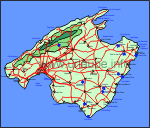
Our domicile in Mallorca was in Porto Petro, a little fishing village at the east coast, so that for our north east tour, we first drove a bit alongside the coast to start in Porto Cristo. There, we visited the dragon caves that resulted to be a deterrent scenario that we only can disadvise. The bathing resorts that arised from the tourism, S'Illot, Sa Coma or Cala Millor surely are not any sightseeings that are worth to mention, but they were on our way to the north so that we had the offer to bath in the sea in between, for the case that the drive was too exhausting.
Anyhow, in the little towns Arta and Capdepera we experienced some little highlights. There, one hikes at Talaiot de Ses Paisses on misterious traces of the dawn history, gets impressions of the medieval history of churches and castles and gets fantastic and wide look-out points through the hills of Serra de Llevant. A similarly fantastic look-out point to us was the Cap de Capdepera at the eastern point of Mallorca with its light house, that formed together with the village Cala Ratjada and Sa Font de Sa Cala the last stations in our tour through the northeast.
Porto Cristo - could be so beautiful without the dragon caves!
As we were travelling from the south in direction to Santanyi, we took the road that was parallel to the coast in order to get to Porto Cristo. On this hilly road we had real fun to drive, as we not only were fast due to the low traffic and the well arranged roads, but we also had in between a fantastic view to the sea from afar. Between the tree plantations at the right and the left there were repeatedely some little goats and flocks of sheep pasturing and at each exit to some Platja (beach) we could have turned right to the beach.
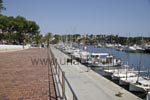
But the more deterrent to us was the entrance into the little city Porto Cristo, that lives up to its name as a tourist place. It is famous for its Coves del Drac, or better said, infamous, colossal buses cavort there in flocks. As a bus driver, we would have caught faster a parking place as with the car. For cars, the places are limited and respectively costly. After driving back and forth and paciently waiting, we found a parking place; We do not know what was more annoying. The long waiting for a parking place or the frantic drivers. In the center of the village there is no traffic reduction and as pedestrians, even on the crosswalk we had to be careful with the racers.
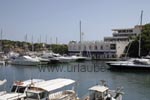
Once one got more or less used to the noise and the bustle in the village, one can slowly open oneself to the beautiful sides of Porto Cristo. The harbour esplanade surrounded by palms is beautifully wide arranged and from there, one can stroll up to the harbour beach. The harbour scape of Porto Cristo is a quite colourful mixture. Beside many little sailing boats there are occasionally also bigger motor boats, as for example in front of the Club Nautic, that is located at the opposite side of the esplanade.
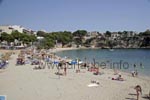
If one loafs alongside the esplanade, one arrives to the beach of Porto Cristo, of which we were more than pleasantly surprised; Protected by the upstream dock, the water stays very calmed, runs widely shallow into the sea and for the children, the numerous paddle boats and slides that are located into the water provide diversion. Due to the reason that in the esplanade there are all imaginable little shops, coffee bars and restaurants running upside the beach, during bathing it is possible to have in between a shady break. But what is much more important: as all people pilgered to the lion's cave, at least at the time we where there, the beach was passably protected from the tourists overflowings. Thus, those who make a stopover in Porto Cristo can spread out in the beach without bad conscience, instead of torturing oneself with loads of other people in the dragon's cave. If we knew that before!
Coves del Drac: Dragon's cave = mass cave
As nice as the little place Porto Cristo resulted to be after the first determent, the determent of the dragon's caves was never ending. We are surely not any doom-merchants or pessimists, but here we are absolutely convinced: It will never be that one can experience a nearly satisfying excursion there.
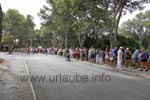
Please put yourself into the following situation: you are thirsty, stand since half an hour in the burning heat, put on specially long pants, as in the cave it will be cold, you don't find any place to sit, and you are surrounded with people within a distance of 15 centimetres, from blaring kids to know-it-all pensioners, any type is represented, and later, it will get more tight and cuddly.
Then we also can briefly describe our experience plastically: queue up, fork out heavily, back to stand in the ardent sun, blatant and grumpy children, frustrated parents, in single file with thousands of other people squeezed trhrough the caves, crammed in narrow bank rows, the knees of the man behind in one's back, again, long wait in the dark until the bank rows are fully occupied, again, blatant children, authoritarian ushers that prohibit to take pictures, 2 boats that are adorned with tasteless light bulbs in the dark, on which 3 musicians play tasteless music, wait until all stood up and go in single file and squeezed upwards through the cave's corridors. 100% frustraded faces in the day light - finally, one can breath deeply again, wait in front of the toilets, stunned and unendlessly disappointed back to the car.
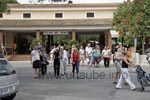
It would not have been so bad if it wouldn't havwe taken so long and if it wouldn't have been so exhausting, if it wouldn't have been so expensive and the salary that those people earn there would not be tear-inducing. It was not a fun at all! And those who have the idea that the cave's would offer a pleasant chilling to the summer heat, we have to deeply disappoint them. Due to the many thousand people that are squeezed into in periods of one hour, the warming factor is huge. We even put some long pants on before the event. It was horrific! We even sweat more by queueing in the sun and in the cave, it was not cold at all. And the rocks, they also were not impressive at all.
Even if it is advertised that this is one of the biggest caves with a subterranean sea, we can only disadvise from waisting time and money there; Accordingly, we abstained from any further excursions to other caves that for example are close to Arta. We don't know how it is there. But due to the numerous visitors that want to go no matter what it takes to see the caves of Mallorca according to the high recommendations of the traval guides, we think that it is not less profit made or less bustle there.
Conclusion: that what the travel guides prise to be a top-tip is, according to our opinion, an absolute top-ripoff, top-flop or simply: well organised mass ripoff. We haven't seen much of the cave itself, the stalagmites and the stalactites were somewhere behind the crowds. The fact that the cave is big was only noticed by us by the fact that between 500 and 1000 people were there at one. For those who want to visit and enjoy a real stalactite cave I can recommend the domestic caves of the Swabian mountains, as the sinuse of the bear's den. They might be a little smaller, but they are enjoyed together with 10 persons so that it is possible to see things, and no with 1000 other visitors. There are no pictures of the cave, as it was prohibited to take pictures in the interior. Therefore, it is possible to buy some post cards...
After this exertion we first wanted to relax. Thank god that our next stations led us into the deeper north straight to the beach in S'Illot and Sa Coma; Nevertheless, meanwhile, our only demand was only to dive into the water and get a little place in the beach to relax.
S'Illot und Sa Coma: Beach as far as the eye can reach
S'Illot and Sa Coma are in fact two bathing resorts which merge into one another. Both are of a similar style: many hotels, tourists-ghettos with buildings partly as high as high-risers, not to say dosshouses as far as the eye can reach. But therefore surely a bargain. So, this isn't for people who attach importance to aesthetics but rather for those who perhaps seek this giant beach at a bargain price for their whole family.
But in return, there is plenty of beach offered. The beach not only has a length of a few kilometres but is also quite broad. We could drive in the streets between the hotel rows stright up to the beach and found also quite soon a free parking place right on the street. Despite of the crowds we still got a rather quiet impression. So, despite the bargain price, there is no audience like "Ballermann" (german pub in Mallorca with a bad reputation) but rather beach holidays for the whole family.
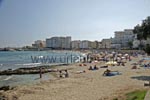
In general, the place appeared to be very well-kept and the beach is apparelled with the usual offers which can be expected in a local beach. Beside the lifeguards and the deck-chair rentals there are an abundance of opportunities alongside the beach to have a snack in between. Whether it is a takeaway, coffee bar or a restautrant - there is a choice for everybody.
Even if we now had enough possibilities to relax from the stressful dragon's cave by swimming, we did want to make a side trip into the little town Cala Millor. Cala Millor is also famous for having a wide beach.
Cala Millor: It is hard to spend a more typical beach holiday
On the way to Cala Millor, the hotel complexes and the high rise buildings are already visible; At each corner there are signs of the german supermarkets Lidl and Spar so that you realize immediately that it is a touristic area without any tradition. But it doesn't matter, as the beach that Cala Millor offers simply appears to be miles away. Thus, it is basically regardless which of the many streets you choose to get to the beach.
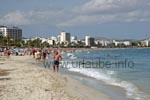
We got a free parking place rather quickly which was located right on the street close to the beach. Thus the hotel rows are not fully located at the beach but separated from it by a wide boardwalk, it creates a feeling of wideness. In this way, it is possible to put the hotels in the background of one's attention, although they may appear to be quite beamy. But we doubt this works as well as for the crowds which came across. At the time we were there, we probably had bad luck. The cleaningless left to be desired, however, this can be different in other seasons.
Besides, we have seen anything which can be important for a typical beach holiday: a wide long sand beach which runs flat into the water, many snorkeling tourists and families with children, lifeguards and deck-chair rentals. Now we felt again like seeing some culture, so we went on the way to Arta, further in north direction in the upcountry.
Talaiot de Ses Paisses
Talaiot de Ses Paisses is the way the stone accumulations are called that are only located at two minutes by car from Arta; The time of their origin is estimated at approximately 1000 B.C. and they can be considered as the origin of the time in that Mallorca was early populated. Unfortunately, it is often not mentioned in the travel guides at what times the lunch breaks are held, so that one should take into account that between approximately 12 and 3 p.m. siesta is held.
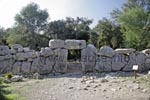
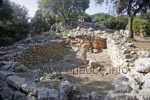
The word Talaiot is an archaeological technical term with which the stone accumulations - in this case the ones in Mallorca - are described. Until now, the meaning and the function of these buildings in Mallorca are not known. Different to the other findings as for example in Egypt, in which from different hieroglyphics the significance could be derivated, such hints are completely missing. It remains unknown whether these accumlations of stone served as home, sultside or sepulture. The same thing can be said about the atmosphrere whith which we visited this area. Questionmarks and more questionmarks. Those who like to get into the spirit of the stones and the nature might be dive into his own world ogimagens and phantasies, a thing that might have happend in this place in that time and also during the history in between. But those who look for logical answers will surely remain helpless, specially with the questions how this stones hace been transported to this place without any tools and auxiliary material.
Arta
Arta is located at the north east of Mallorca and accessible through little curvy roads to the heartland. At a distance of approximately 15 to 20 minutes by car from the coast located at the east and the north, an impressive brackdrop is visible in the approach. With its nearly 6000 inhabitants, Arta is is the biggest place of the same named community; Even if Arta should be rather considered as one of the smaller places of Mallorca, it impresses even more by its conserved origin in tradition, culture and last but not least its arquitecture.
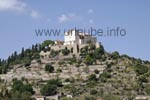
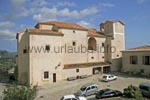
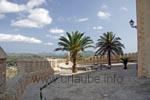
The traditional buildings in the core center of the old town reminds on past epoches, and specially the fortress hill with the church of pilgrimage Sant Salvador and the community church grant Arta an imposing character. Built at the bottom of the mountain, the fortress that thrones on the top of the mountain is recognizable from afar.
By amplifying the first picture, the position of the two churches to each other are very good to see. If one drives by car, it is not so easy to find the access to both of the churchs. Without any signpostings, one has to go step by step upwards the alleyways without loosing the orientation. Upside, at the level of the mountain, the Church of pilgrimage Sant Salvador was built, that is surrounded by very well conserved battlements. Straight underneath these battlements there is the gothic community church Transfiguration del Senior, that has been extended by a museum.
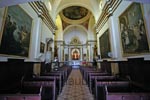
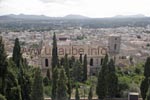
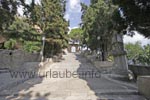
The alleyways have the advantage, that the church of pilgrimage is saved from the rush of the tourist buses and results to be a cozy little place far beyond any turbulence. On one side it is comfortable to get a parking place even at the fortress hill, but on the other side it makes it loose some of its charm. Here, there is the possibility to rest in a coffee bar with some coffee and cake and also the kiosk got a bonus for a very well-kept and handicapped accessible toilet.
The patio around the church of pilgrimage invited to a quiet rest. There are some stone banks under the palms from where one can enjoy the view unter the protective shade. The view from here is simply gorgeous. One sees the back-country with paddocks, fincas and the surrounding mountain scenery Serra de Llevant, when the sky is cloudless, the view is even possible up to the impressive mountain chain Serra de Tramuntana in the west. The church of pilgrimage itself was built around 1830 and can be visited today. The paintings of the interior of the church reperesent historical scenes in an impressive way.
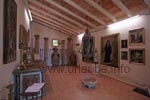
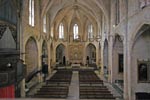
By loafing a little further in the area, one sees the place Arta itself and the community church Transfiguration del Senior. In order to get to the community church it is possible to get fron here on foot on a path surrounded by trees, that marks with its 180 stairs the pilgrimage route to the Church of pilgrimage. The small, very well conserved stairs are not specially high, but in the heat one does start to sweat.
The interior of the parish church is accessible but it is not for free, one gets there with the ticket to the museum. That what is visible today in front of the church is mostly from the 16th century, even though the origin of the church goes back op to the 13th century. The museum is an accumulation of worthy historical objects as little old columns, church banks and specially paintings.
Arta definetely belongs to the places in which there is more to discover. Indeed, it is touristically not much developed but with some galeries, a museum and many restaurants with the country typical dishes and by this way, one can go deeper into the history of Arta. For us, it was nearly difficult to continue that day instead of staying there, but we wanted to go to our next station: the church Betlem further into the north of Arta.
Ermita de Betlem: Lonesome convent in the mountains
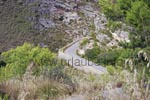
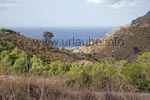
Ermita de Betlem is only accessible by car from Arta. On a distance of approximately 10 kilometres, one indeed drives on well built but partly very narrow serpentines into the mountains. It is not recommendable to wait until the end for taking some pictures, as the highest point of the distance is already reached 1 km before the Ermita. Indeed, it is surely not easy to stop in a not clearly arranged road for a couple of pictures, but with the view that one has on the way it is definetely worth.
One should not expect a special lookout point at the Ermita. This spot is more a place of quietness, if one turns blind to the tourists, that although the drive is so long, they still appear there. In front of the big gate that already restricts the Ermita from afar, it is possible to park the car at the roadside. From here, one can walk alongside a long extended cypress avenue up to the Ermita de Betlem that was built in the year 1805.

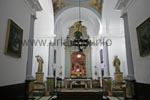
Disregarding the electrical candles that can be linghtened for money, the Ermita de Betlem rather appears in the interior to be of a basic arrangement that corresponds to the rural and simple atmosphere there. One can see a little further to the hilly grassland to get a better view. From here, under good visibility conditions it is possible to see the bay of Alcudia.
After we enjoyed for a while the quietness of the Ermita de Betlem, we felt again like having more bustle. Our next stations should get us to the Castell de Capdepera and to Cala Ratjada. This meant to us that we had to go back all the way to Arta in order to get after further 8 km by a direct communication road to Castell de Capdepera.
Castell de Capdepera: Impressive battlements
The battlements of Capdepera, one of 53 autonomous communities of Mallorca, are already visible from afar during the way. The well conserved towers and castle walls from the year 1337 are placed amid the city on a hill overgrowned with forest. In the narrow alleys it is difficult to deal with the car, also the travel guides recomend to better leave the car on a parking place amid the town and continue on foot. Thus, only because of our ambition and rather by coincidence we found the way that was signposted in direction to Cala Ratjada, a narrow one-way-street that leads up to the entrance gate of Castell.
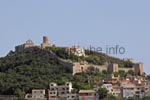
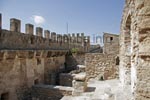
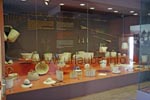
If one is lucky, he gets a parking place right in front of it, otherwise one has to drive along this one-way-street up to the next opportunity at the roadside. In order to visit the Castell de Capdepera, there is a little to pay for the entrance and one also gets an overview of the fortress. In an appendant museum it is possible to get informed about the traditional craftwork of making baskets. Due to historical researches it was possible to determine that the production of baskets in Mallorca has even an older origin than the pottery. For this, palm leafs are braided to objects of the daily use that still today can be bought in different markets of Mallorca.
If one goes around in the interior of the castle complex of Capdepera, one has to deal with some very cliffy cobblestone paths. But the castle walls are very well conserved and it is possible to move freely everywhere and to circle the Castell completely. No matter what the efforts to get here were: not only each of the well conserved parts of the building of the castle themselves, but also the view from here is fantastic. Thus, those who are having their holidays in the north of Mallorca should not miss to visit the Castell de Capdepera.
Cap de Capdepera: the most eastern point of Mallorca
A further highlight of the community Capdepera is the Cap de Capdepera. With its light house, the Far de Capdepera, Cap de Capdepera marks the most eastern point of Mallorca. In order to get there, one drives through the little village Cala Ratjada, that with more than 500 inhabitants is the biggest place of the community Capdepera. The way to Far de Capdepera leads in Cala Ratjada alongside the harbour at the right side and passes Cala Gat on a nice vegetated street.
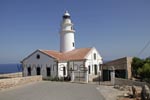
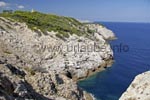
The area of the light house was - as mostly all of the light houses in Mallorca - locked, but instead, the most impressive coast view opened to us. The cliffs fall right in front of one steeply downwards into the deep blue sea. The water beats white spumous waves to the paltry rock formations that provides a very romantic atmosphere with the little white sailing boats afar. From here, the direct view to Cala Gat is barred by some trees, but those who are good in walking can walk alongside the narrow stony path and after some steps he will have a free view.
Cala Ratjada - a peninsula with plenty of beaches
At first sight, the center of Cala Ratjada is very appealing. With the harbour that is surrounded by a well-kept esplanade, the many old trees that also convert the shopping malls into shady strolling miles one feels like staying for a while. One first hardly notices in the restaurants of the centre that Cala Ratjada rahter is described as a typcal bathing resort: it straight offers a few and partly quite big beaches and the vision that one gets of Cala Ratjada at the beaches is respectively different: there are hotels everywhere as far as the eye can reach and german shopping markets on each of the streets.
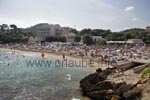
But this might just be the reason why Cala Ratjada is also popular among the german people as a low priced holiday place. Those who like to swim, even if the beach is right in front of the door, can choose between three bays: Platja son Moll, Cala Agulla and Cala Gat.
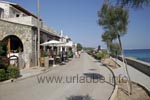
The beach Platja son Moll is not a continuously wide beach but rather a wide oval running backwards. So, if you are unlucky and lie in the row of towels no. 12, there are some metres to walk to get to the water. But in return, the water is very clear and the beach is very well-kept. Indeed, it is not as flat sloping as we were used to in other beaches, but it also does not go into depth like a riff. There are an abundance of kiosks and ready lifeguards but in general, the panorama appears to be rather poor: the high hotel buildings are not very attractive, but instead, the boardwalk is. If you walk the boardwalk further in direction to the harbour, you will arrive at Cala Gat which is a wide bay of Cala Ratjada.
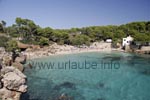
In order to get to Cala Gat there is no obligation to walk along the boardwalk, even though the view to the bay is worthwile. You can also get there straight on the way to Cap de Capdepera, the look-out of Cala Ratjada. Indeed, Cala Gat is a tiny, cosy bay surrounded by cliffs and trees but, according to the crowds there, definitely too small. Thus there is a bigger hotel behind the bay, there is barely space and people seek after places for sunbathing up to the kiosks and the dust bins beside it. Also, the places of shade are rare. Unfortunately, at the time we were there, we were not only unlucky to have to lie squeezed among the others, one towel after the other, but there was also a plague of jellyfishes. We could not see any lifeguards or rentals for parasols.
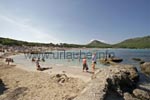
Cala Agulla is a dune beach extended over approximately 600 metres which can be also reached very well on foot. Although there can be a lot of bustle there due to the abundance of hotels, the crowds are widely spread all over the beach. The places for sunbathing on the beach are widely used up to the dunes and we finally could get a feeling of a certain quietness. In general, the panorama appears to be very wide and open - this is not only caused by the view to the leafy hills in the background but also by the opportunity to swim far into the open sea. The light sand beach runs even and wide-ranged into the water and plenty of little ledges arouse curiosity for skin-diving.
Sa Font de Sa Cala: little posh place with a quiet beach
We rather came by coincidence to Sa Font de Sa Cala. In fact, after the deterrent experience in the dragon's cave we did not plan to visit another cave in Mallorca, but after we saw on the map that the Coves d'Arta only were a stone's throw in southern direction of Cala Ratjada alongside the coast, we went on the way to Font de Sa Cala.

The perfect shortcut seemed to be there, but it was an error in reasoning, as we did not plan the sea bay... Indeed, we could not continue from Font de Sa Cala, but instead, we drove through a nice, posh and green district were one villa followed the next.
At first sight, the little area appeared to be unimpressive but if you drive further alongside the beach you will arrive at a posh, leafy district where one mansion follows the next. Accordingly, the beach also appeared to be a little and exclusive highlight. Indeed, the dimension is rather dapper but therefore very well-kept and quiet, we could calmly enjoy our coffee at the beach bar.

Back to the index Mallorca
Copyright: Patrick Wagner, www.tourist-guide.biz
|